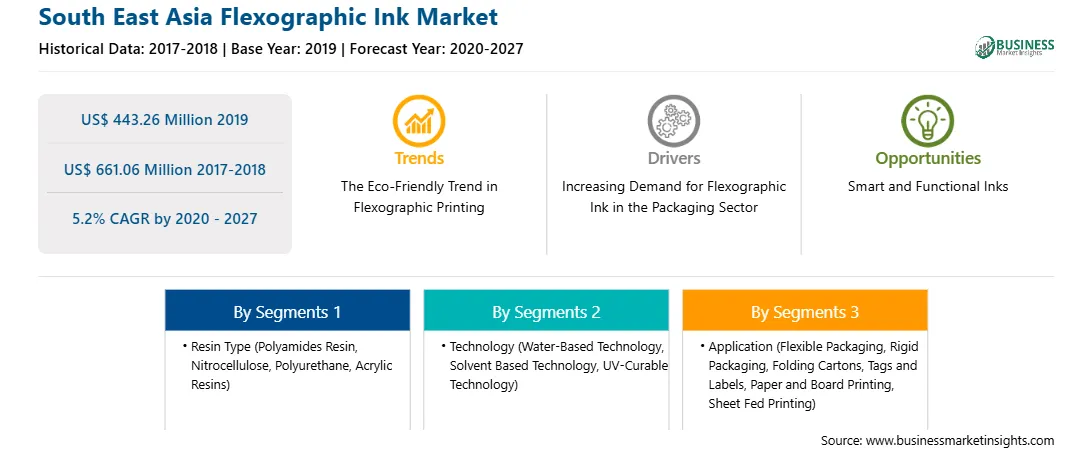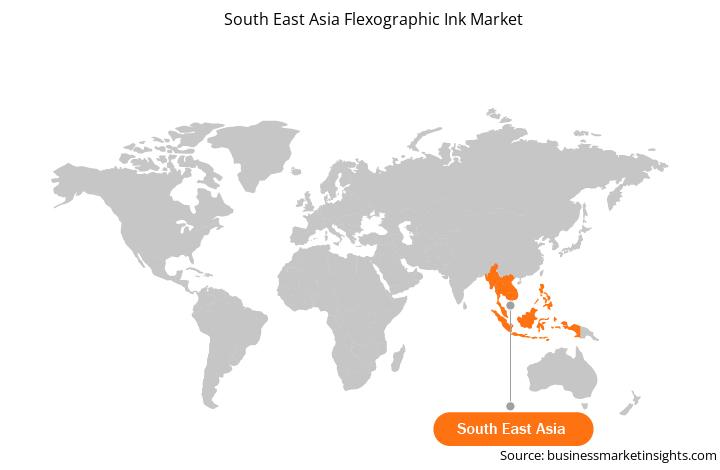Flexographic ink, also known as flexo printing ink, is used in the printing of packaging materials such as cardboard boxes, packaged food, paper bags, plastic bags, and newspapers. There is an upsurge in demand for flexographic inks from the packaging industry due to the growing focus of manufacturers on the development of attractive packaging methods and materials for their products. UV curable ink is gaining high acceptance over other inks such as water-based ink and solvent-based ink due to its advantages such as high production output, superior bonding, low volatile organic compound (VOC) content, lowered drying time, reduced rejection rates, and better solvent resistance properties. The demand for UV-curable inks has also increased on the back of continuous changes in environmental regulations, and growing awareness and rising concern toward improving the safety of packaged foods. Technological advancements in the field have reduced the risk of fading, delamination, and bubble formations, which is anticipated to further drive the demand for flexographic inks.
The South East Asia flexographic ink market is expected to reach US$ 661.06 million by 2027 from US$ 443.26 million in 2019; it is anticipated to grow at a CAGR of 5.2% from 2020 to 2027. Growing demand for flexographic ink from the packaging industry and increasing use of UV-curable inks drive the market growth. However, shifting preference from print media to digital media limits the growth of the market in South East Asia.
Based on resin type, the polyurethane segment accounted for the largest share of the South East Asia flexographic ink market in 2019. In terms of technology, the water-based technology segment is expected to hold the largest share of the market by 2027. Based on application, the flexible packaging segment held a significant share of the South East Asia flexographic ink market in 2019.
A few major primary and secondary sources referred to for preparing this report on the South East Asia flexographic ink market include DIC Corporation, Nazdar Ink Technologies., Sakanta Inx Corporation, SiegwerkDruckfarben Ag and Co. KGaA, T& K Toka Co. Ltd., Toyo Ink SC Holdings Co. Ltd. and Swan Coatings (M) Sdn. Bhd.
The COVID-19 outbreak first began in Wuhan (China) in December 2019, and since then, it has spread at a fast pace worldwide. As of September 2020, Malaysia, Singapore, Thailand, and Vietnam are among the highly affected South East Asian countries in terms of confirmed cases and reported deaths. The COVID-19 pandemic has been affecting economies and industries in various countries due to lockdowns, travel bans, and business shutdowns. Chemicals and materials is among the major industries facing serious disruptions.
Strategic insights for the South East Asia Flexographic Ink provides data-driven analysis of the industry landscape, including current trends, key players, and regional nuances. These insights offer actionable recommendations, enabling readers to differentiate themselves from competitors by identifying untapped segments or developing unique value propositions. Leveraging data analytics, these insights help industry players anticipate the market shifts, whether investors, manufacturers, or other stakeholders. A future-oriented perspective is essential, helping stakeholders anticipate market shifts and position themselves for long-term success in this dynamic region. Ultimately, effective strategic insights empower readers to make informed decisions that drive profitability and achieve their business objectives within the market.

| Report Attribute | Details |
|---|---|
| Market size in 2019 | US$ 443.26 Million |
| Market Size by 2027 | US$ 661.06 Million |
| Global CAGR (2020 - 2027) | 5.2% |
| Historical Data | 2017-2018 |
| Forecast period | 2020-2027 |
| Segments Covered |
By Resin Type
|
| Regions and Countries Covered | South East Asia
|
| Market leaders and key company profiles |
The geographic scope of the South East Asia Flexographic Ink refers to the specific areas in which a business operates and competes. Understanding local distinctions, such as diverse consumer preferences (e.g., demand for specific plug types or battery backup durations), varying economic conditions, and regulatory environments, is crucial for tailoring strategies to specific markets. Businesses can expand their reach by identifying underserved areas or adapting their offerings to meet local demands. A clear market focus allows for more effective resource allocation, targeted marketing campaigns, and better positioning against local competitors, ultimately driving growth in those targeted areas.

The List of Companies - Southeast Asia Flexographic Ink Market
The South East Asia Flexographic Ink Market is valued at US$ 443.26 Million in 2019, it is projected to reach US$ 661.06 Million by 2027.
As per our report South East Asia Flexographic Ink Market, the market size is valued at US$ 443.26 Million in 2019, projecting it to reach US$ 661.06 Million by 2027. This translates to a CAGR of approximately 5.2% during the forecast period.
The South East Asia Flexographic Ink Market report typically cover these key segments-
The historic period, base year, and forecast period can vary slightly depending on the specific market research report. However, for the South East Asia Flexographic Ink Market report:
The South East Asia Flexographic Ink Market is populated by several key players, each contributing to its growth and innovation. Some of the major players include:
The South East Asia Flexographic Ink Market report is valuable for diverse stakeholders, including:
Essentially, anyone involved in or considering involvement in the South East Asia Flexographic Ink Market value chain can benefit from the information contained in a comprehensive market report.